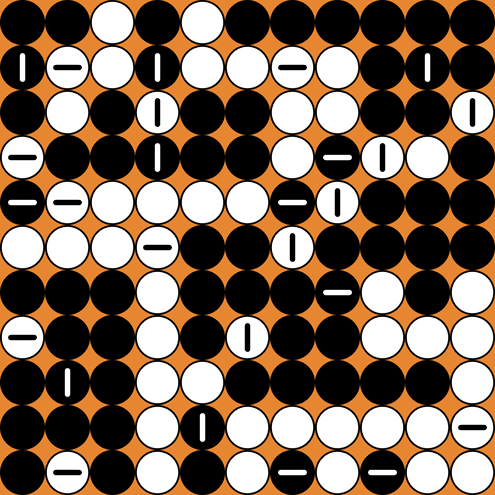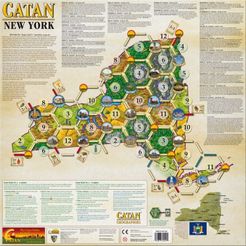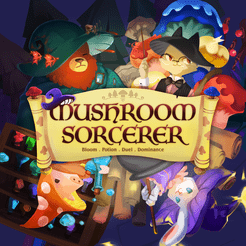|
Advertisement
|
Rumbo

DescriptionIntroductionRumbo is a finite territory game for two players: Vertical and Horizontal. It's played on the intersections (points) of an initially empty square board. Both players must have access to a sufficient number of stones in two colors and a sufficient number of vertical and horizontal markers. DefinitionsIn these rules, "adjacent" always means "orthogonally adjacent". A group is a maximal set of orthogonally connected, like-colored stones. A liberty of a group is an empty point adjacent to it. A hole is an empty point such that all points adjacent to it are occupied by stones of the same color. To claim a group is to place a marker of yours on top of one of its stones. The four orthogonal adjacencies of a point are named after the cardinal points. Vertical owns the north and south adjacencies, the pairs north-south, north-east and south-west and the triplets north-south-east and north-south-west; Horizontal owns the east and west adjacencies, the pairs east-west, north-west and south-east and the triplets east-west-north and east-west-south. PlayVertical plays first, then turns alternate. On their turn, a player must place one stone of any color on an empty point without creating any holes. Then, each unclaimed group without liberties is claimed by the player who owns the set of adjacencies of stones in that group to the stone just placed. The game ends when the board is full. A player's score is the total number of stones on the board in groups that they have claimed, plus a komi in the case of Horizontal. The player with the highest score wins. KomiThe komi is the number of points which is added to Horizontal's score at the end of the game as a compensation for playing second. Before the game starts, the first player chooses the value of komi, and then the second player chooses sides. To avoid ties, the parity of komi should be different from the parity of the board size. Game DiscussionsAdd CommentYou need to be logged in to comment. Insert Bullet List Please enter at least one item. Item: Item: Item: Item: Item: Insert Numeric List Please enter at least one item. Item: Item: Item: Item: Item: Insert Link Please enter the link of the website Optionally you can add display text Insert Email Please enter the email address Optionally add any display text Insert Image Please enter the link of the image Insert YouTube Video Please enter the link of the video MarketplaceNo listings at the moment. Do you own this game? Click here to list it for sale.
|
Best Sellers
Board Games
|
||||
Latest Searches: spidey | Funglish Board Game | 6-inch action figures | up to your @*! in alligators | Louisville opoly | white castle | silver+dollar+city+monopoly | Iron man mask | happy wheels | snapple | Saint | transformers: robots in disguise combiner force legion class blurr | fireboy and watergirl | Puerto rico | Monopoly Osnabrück | Monica | Mensch ärgere | Ma sói | Le Héraut Citadel | Las Vegas | It’s bananas | It’s a deal | Howard’s poly | Hero’s quest | Hasbro Gaming The Slow-Motion Race Game for Kids Ages 8 | Harry Potter 4 inch Collectible Wand – Mystery Box with Die-cast Wand with Stand | The Wand Chooses | Geek d’Argos | Frozen don’t break the ice | Flick èm Up | PREMIER LEAGUE
All Rights Reserved











Comments (0)